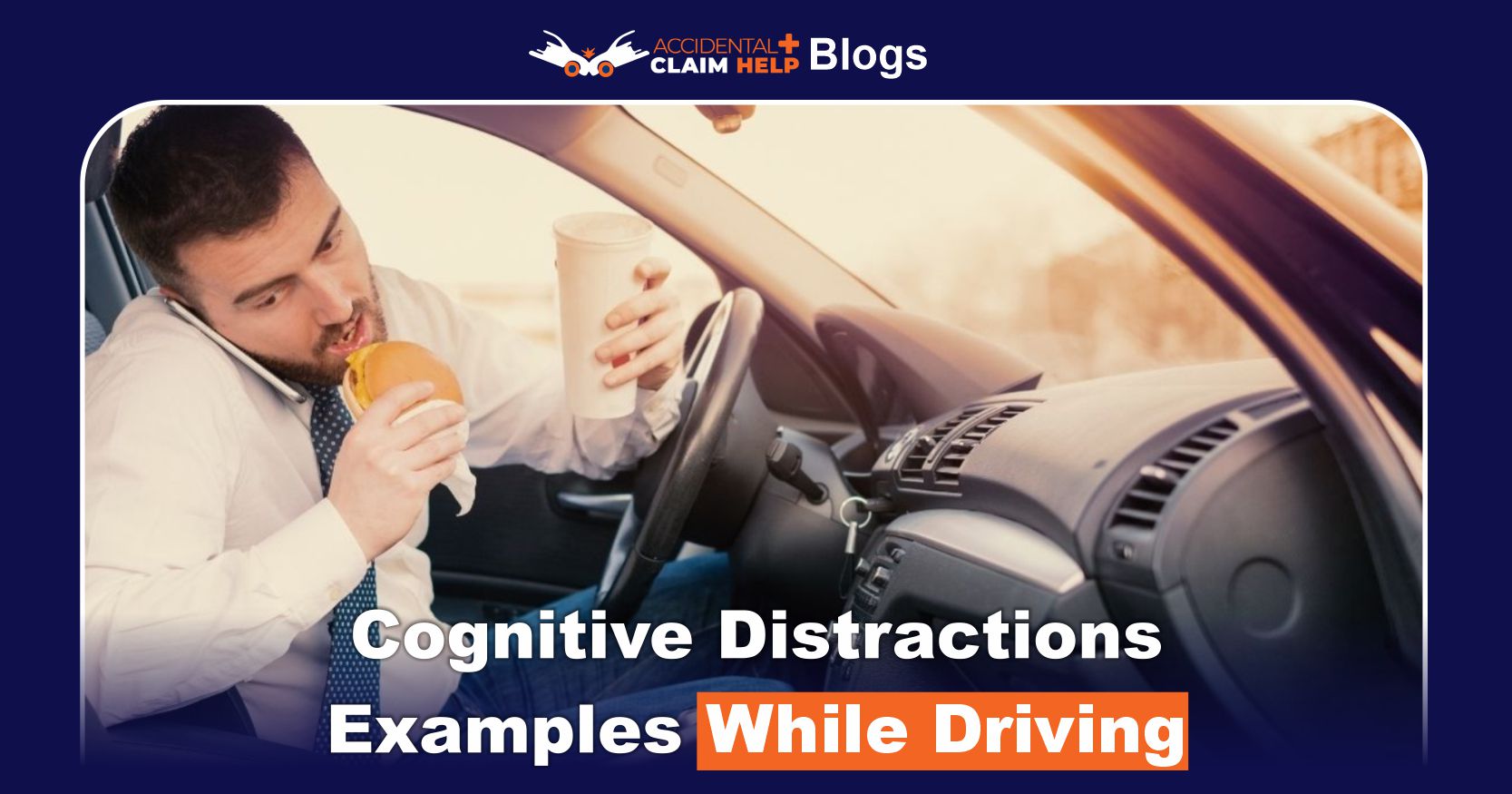What are Cognitive Distractions: Examples While Driving
When most people think of distracted driving, images of a driver looking at their phone or eating behind the wheel come to mind. But some of the most dangerous distractions aren’t physical—these are cognitive distractions, where a driver’s mind wanders away from the task of operating the vehicle. In the United States, cognitive distractions contribute to crashes every day, often in subtle ways that the driver may not even realize. This article explores what cognitive distractions are, why they matter, and provides concrete examples and strategies to reduce them.
What Are Cognitive Distractions?
A cognitive distraction occurs when your mental focus is diverted away from driving. Unlike visual distractions (taking your eyes off the road) or manual distractions (taking your hands off the wheel), cognitive distraction is about what’s happening in your head.
- If you’re stressing over a work problem, planning your weekend, or thinking about an argument, your mind is not fully available to detect changes in traffic or hazards.
- Even tasks that don’t require hands or eyes—such as a phone conversation—can impose mental workload that degrades reaction time, situational awareness, and decision-making.
Cognitive distraction is harder to detect or measure, but research shows it plays a role in many crashes. The AAA Foundation and other safety studies note that many in-vehicle behaviors (phone calls, phone voice commands, deep conversation, listening to complex content) carry cognitive load even when hands and eyes stay where they should. (AAA research)
In fact, using a hands-free phone or voice command system doesn’t eliminate distraction—drivers are still mentally engaged with the secondary task. (NTSB commentary)
In the U.S., distracted driving (including cognitive distraction) is a major safety issue. The Centers for Disease Control and Prevention (CDC) classifies distracted driving into three types—visual, manual, and cognitive—and notes that any of those can increase crash risk.
You May Read: Is It Illegal to Drive with Headphones
Why Cognitive Distractions Are Dangerous
Here’s what makes cognitive distractions particularly risky:
- Delayed reaction time
When the brain is preoccupied, it responds more slowly to sudden threats—braking, lane changes, or merging. - Reduced hazard awareness
Drivers may fail to recognize changes in traffic patterns, brake lights ahead, or pedestrians stepping into the road. - Tunnel vision or perceptual narrowing
The mind focuses on one thing (the distraction) and “filters out” peripheral stimuli—less attention to road edges, signs, or surrounding vehicles. - Overconfidence / unawareness
A driver may believe they can multitask safely. But cognitive capacity is limited—attempting to divide attention often backfires. - Cumulative load
Even seemingly mild distractions can add up—over a long drive, fatigue plus mild cognitive tasks can degrade performance.
Studies (including naturalistic driving research) show that younger drivers and older drivers may be more susceptible to the negative effects of cognitive load. (Virginia Tech & VTTI)
Given that cognitive distractions are “invisible” (you don’t see hands or eyes leave the road), they are harder for others (or law enforcement) to detect—but equally dangerous.
Real-World Examples of Cognitive Distractions While Driving
Below are concrete examples of cognitive distractions commonly encountered by U.S. drivers. Many of these occur in everyday driving, often innocently.
1. Deep conversation or emotional argument
- A heated discussion with a passenger about finances, family conflict, or personal issues can absorb mental energy.
- While talking, your thoughts wander to not just what you’re saying—but how you’ll respond, what you forgot, what’s next—diverting focus from the road.
- The emotional content (anger, sadness, stress) further taxes mental bandwidth.
2. Phone call (even hands-free)
- Accepting a call via Bluetooth, speaker, or voice command consumes cognitive resources—comprehension, formulating responses, listening.
- Drivers often underestimate how much a phone conversation taxes attention, thinking it’s “safe” because hands and eyes are free.
3. Listening to podcasts, audiobooks, or complex media
- Engaging content—storytelling, news, moral dilemmas, technical lectures—can pull your attention into the narrative.
- When traffic conditions shift (e.g., sudden braking ahead), your mind may lag in disengaging from the content and refocusing on driving.
4. Navigation under stress / route planning
- Actively thinking about where to turn, recalculating routes, evaluating alternate roads—or worrying about being lost—consumes brain capacity.
- This can be especially distracting in dense urban settings or highway interchanges.
5. Worrying, daydreaming, or “mind wandering”
- The mental drift is very common—thinking about tomorrow’s tasks, arguments, finances, health, relationships.
- On familiar roads or during long, monotonous trips, the risk of “autopilot” mode increases, where you go on “mental cruise control.”
6. Emotional states / anxiety / stress
- Driving while upset, anxious, or emotionally burdened reduces your mental agility and situational awareness.
- You may fixate on the source of stress and slow in decision-making or suspect phantom dangers.
7. Multi-tasking trivial tasks
- Mentally composing a text, email, or message (even if you don’t type it yet) in your mind.
- Planning errands, remembering to buy something, remembering a prior conversation.
- Mentally doing calculations, checking your schedule, doing “in your head” tasks.
8. Predicting or ruminating on past or future incidents
- Replaying a past collision, mistake, or traumatic event distracts the mind from the current driving environment.
- “What if” thinking—e.g. “What if someone cuts me off?”—can provoke anxiety-driven distraction.
9. Use of voice assistants or in-car voice commands
- Asking voice assistants to send a message, search for music, or change settings still involves processing, interpreting, and waiting for responses.
- Even though it is “hands-free,” the mental load is non-negligible.
10. Partial automation / semi-autonomous driving
- When drivers use adaptive cruise control, lane-keeping assist, or semi-autonomous features, they may relax mentally, assuming the system will handle more.
- This overreliance can lead to disengagement, reduced vigilance, or daydreaming. A study found that drivers using partial automation were more likely to engage in distractions like phone usage or eating.
Patterns & Statistics in the U.S.
- In the U.S., distracted driving contributes to thousands of fatalities and tens of thousands of injuries annually. The CDC reports that distracted driving (of which cognitive distraction is a part) contributes to crash risk.
- Observational studies show that a nontrivial share of drivers are engaged in smartphone tasks (texting, calling, social media) at any moment.
- The IIHS (Insurance Institute for Highway Safety) found that in a 2023 survey, over 20% of U.S. drivers reported using their smartphone for video, social media, or calls on most or all trips.
- Naturalistic driving research (e.g. by the Virginia Tech Transportation Institute) has demonstrated that text messaging increases crash risk significantly (e.g. many times higher odds), partly due to the combined visual, manual, and cognitive load.
- Safety agencies emphasize that even “hands-free” devices are not risk-free: the conversation itself is a mental load and qualifies as cognitive distraction.
How to Recognize When You’re Experiencing Cognitive Distraction
Because the distraction is mental, it may not be obvious. Here are warning signs:
- You miss turns, exits, or road signs.
- You suddenly find yourself drifting out of your lane.
- You take longer to react to changing traffic or objects entering your path.
- You replay a conversation or thought unconsciously.
- You feel “zoned out” or realize you don’t remember the last few miles.
- You find your mind repeatedly returning to the secondary task or emotional focus.
Strategies to Prevent or Mitigate Cognitive Distraction
Here are practical steps U.S. drivers can use to reduce cognitive distraction and improve safety:
1. Prepare before driving
- Set GPS, climate, playlist, and phone settings before you begin.
- Map the route mentally or glance at it ahead of time.
- Choose content (audio books, podcasts) that is less attention-demanding for driving.
2. Use “Do Not Disturb” / driving mode on your phone
- Many smartphones offer a “Do Not Disturb While Driving” mode that silences notifications or auto-replies to texts.
- Limit incoming calls; only urgent ones should come through (and use them sparingly).
3. Delegate mental tasks or share with passengers
- Ask a passenger to handle navigation, radio, or calls.
- Avoid initiating emotionally intense conversations while driving.
4. Pause on mental tasks
- If you catch your mind drifting or you’re thinking of something heavy, refocus with a mental cue—e.g. tell yourself: “Eyes forward, road ahead.”
- If needed, find a safe place to stop and collect thoughts.
5. Avoid multitasking
- Don’t “compose messages in your head” or plan errands while driving.
- Postpone mental load–heavy tasks until you’re parked.
6. Use simpler audio content during dense traffic
- When in heavy traffic or unfamiliar roads, switch to ambient music or light content instead of narrative-based podcasts.
- Reduce audio volume to improve your mental bandwidth for driving.
7. Stay mindful / mental checks
- Conduct mental check-ins: every few minutes, consciously assess surroundings, your speed, and upcoming hazards.
- Practice mindfulness to anchor yourself to the driving task.
8. Be extra cautious when using semi-autonomous features
- Don’t use cruise control, lane-keeping, or partial automation as a reason to “zone out.”
- Remain alert, keep hands on the wheel, and avoid mental drift.
9. Avoid driving under emotional or mental stress when possible
- If upset, tired, anxious, or otherwise mentally burdened, delay your trip if feasible.
- Or plan to drive slowly and more cautiously, knowing your mental resources are taxed.
10. Training and awareness
- Defensive driving courses or advanced driver training may include modules on cognitive distraction.
- Public awareness campaigns (e.g. during Distracted Driving Awareness Month in April) stress the invisible risks.
Legal and Safety Implications in the U.S.
- In many U.S. states, laws prohibit the use of hand-held devices for texting or calling while driving. But typically these laws focus on visual/manual distraction; legislatures and courts are still developing how to address the cognitive component.
- In crash litigation, cognitive distraction is harder to prove, but attorneys may use cell phone records, in-vehicle data, dashcam recordings, and expert analysis to argue that a driver’s mental engagement was impaired.
- From a safety perspective, many traffic safety programs emphasize that eliminating only visual/manual distractions is not enough; driver attention must remain on the driving task mentally.
Agencies (e.g. NTSB) have warned that hands-free does not equate to distraction-free. The mental load of a call or command still imposes cognitive distraction.
Given the subtle nature of cognitive distraction, enforcement and prevention rely heavily on education, training, and individual discipline.
Final Remarks
Cognitive distractions—those invisible mental drifts and secondary tasks that pull your mind away from driving—are among the most insidious hazards on U.S. roads. While we often focus on visual or manual distractions, the mind’s diversion is equally dangerous.
Through real-world examples—phone conversations, emotional stress, navigation planning, daydreaming—and research-backed evidence, we see how easily mental load can degrade reaction, awareness, and safe decision-making.







